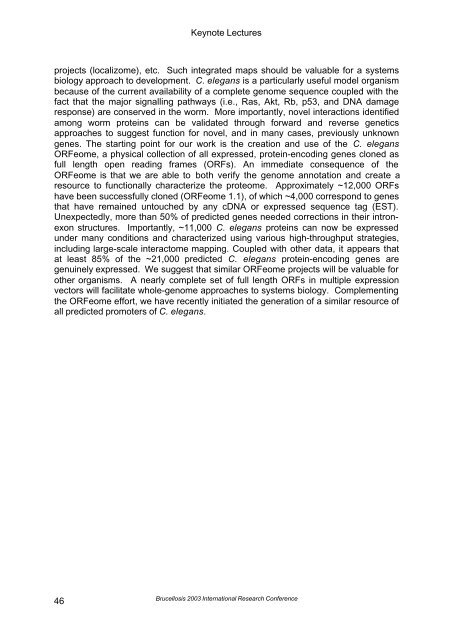Brucellosis 2003 proceedings - PHIDIAS
Brucellosis 2003 proceedings - PHIDIAS
Brucellosis 2003 proceedings - PHIDIAS
You also want an ePaper? Increase the reach of your titles
YUMPU automatically turns print PDFs into web optimized ePapers that Google loves.
Keynote Lectures<br />
projects (localizome), etc. Such integrated maps should be valuable for a systems<br />
biology approach to development. C. elegans is a particularly useful model organism<br />
because of the current availability of a complete genome sequence coupled with the<br />
fact that the major signalling pathways (i.e., Ras, Akt, Rb, p53, and DNA damage<br />
response) are conserved in the worm. More importantly, novel interactions identified<br />
among worm proteins can be validated through forward and reverse genetics<br />
approaches to suggest function for novel, and in many cases, previously unknown<br />
genes. The starting point for our work is the creation and use of the C. elegans<br />
ORFeome, a physical collection of all expressed, protein-encoding genes cloned as<br />
full length open reading frames (ORFs). An immediate consequence of the<br />
ORFeome is that we are able to both verify the genome annotation and create a<br />
resource to functionally characterize the proteome. Approximately ~12,000 ORFs<br />
have been successfully cloned (ORFeome 1.1), of which ~4,000 correspond to genes<br />
that have remained untouched by any cDNA or expressed sequence tag (EST).<br />
Unexpectedly, more than 50% of predicted genes needed corrections in their intronexon<br />
structures. Importantly, ~11,000 C. elegans proteins can now be expressed<br />
under many conditions and characterized using various high-throughput strategies,<br />
including large-scale interactome mapping. Coupled with other data, it appears that<br />
at least 85% of the ~21,000 predicted C. elegans protein-encoding genes are<br />
genuinely expressed. We suggest that similar ORFeome projects will be valuable for<br />
other organisms. A nearly complete set of full length ORFs in multiple expression<br />
vectors will facilitate whole-genome approaches to systems biology. Complementing<br />
the ORFeome effort, we have recently initiated the generation of a similar resource of<br />
all predicted promoters of C. elegans.<br />
46<br />
<strong>Brucellosis</strong> <strong>2003</strong> International Research Conference
















